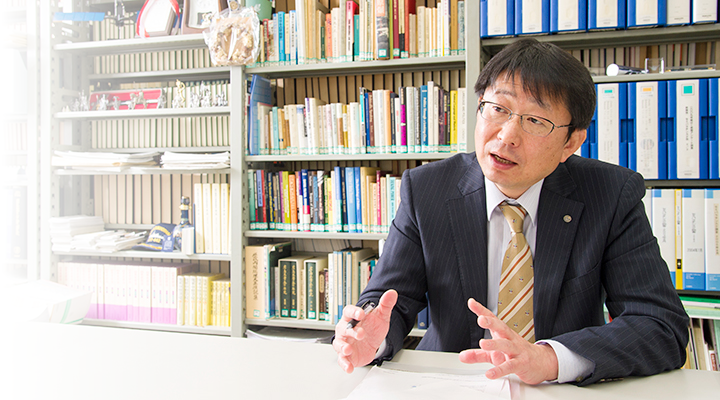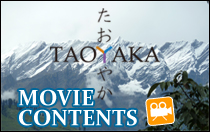
INTERVIEW
Research and surveys of atomic bomb disaster and
nuclear damage from a socio-medical perspective
How is peaceful society of
coexistence achieved, and for whom?
Our initiative takes this
as the starting point
Social Implementation Course
The Center for Peace
Prof. Noriyuki Kawano
Research and surveys of atomic bomb disaster and
nuclear damage from a socio-medical perspective
Research and surveys of atomic bomb disaster and nuclear damage from a socio-medical perspective

The Institute for Peace Science, to which Professor Kawano belongs, is the first academic research organization in the field of peace studies at a national university in Japan.
For this reason, although one might naturally assume that Professor Kawano’s area of specialty is peace studies, he says “I guess the best term for it would be ‘studies of radiation exposure’. To expand on that, it might be close to ‘global nuclear damage’”.
The core part of his research focuses on the atomic bomb survivors from Hiroshima and Nagasaki, and he conducts comparative research on Semipalatinsk, Chernobyl and Fukushima, which have also experienced nuclear damage.
“My largest research topic is the psychological and social impact on atomic bomb victims. I am most interested in how those in socially weak positions who were subject to such unjustified damage can receive welfare benefits for their suffering” says Professor Kawano.
The method he uses is to take surveys of the survivors and examine the average values of thousands of people.
“Rather than speaking for the survivors, what I do is to use the knowhow we can gather to look at the averages, and then, from a researcher’s perspective, to take what we can understand from that and communicate it as the damage from atomic bombing. I always believe that this way of communicating ultimately in a way brings us closer to the atomic bomb survivors and helps to make a contribution”.
This process requires judgment, to ensure that one does not focus too much on the details at the risk of losing sight of the whole. Professor Kawano also has a strong desire in his position as researcher to ensure that his research is useful for the atomic bomb survivors.

It is often said that atomic bomb damage can only be understood if one understands the three fields of medicine, radioactive physics and social science. For this reason, while Professor Kawano’s starting point was social science, he later moved to Hiroshima University Graduate School of Biomedical & Health Sciences (formerly Hiroshima University Graduate School of Biomedical Sciences, Dentistry, and Pharmacology doctoral course) and received his doctorate in medicine.
Professor Kawano also says “There are many things that we don’t know even today, 70 years after the bomb was dropped, so my research on the atomic bomb survivors continues. I am also making use of findings from Hiroshima and Nagasaki in my studies of Semipalatinsk and Chernobyl, to investigate the actual damage suffered by the victims there”. He says that in the future he would also like to do a comparative study of the respective compensation systems in these places.
Peace to the homeland. Peace education learned in Japan becomes a powerful tool

According to Professor Kawano, there are actually various different concepts of peace depending on the country or region.
“There are even different concepts within Japan. Hiroshima and Nagasaki are anti-nuclear. In other words, peace is defined as a nuclear-free world. Tokyo and Osaka are different because they emphasize the ambiguity of the meaning of peace. The definition of peace also differs depending on culture or civilization”.

The definition of peace in peace studies is ‘a world with no direct violence, and no structural violence’. ‘Direct violence’ means a situation where people are physically hurting other people, such as war or conflict. ‘Structural violence’ refers to damage to people’s original potential.
“For example, there are approximately 10 countries in the world where the average life expectancy is around 55 years of age, so life expectancy is being hindered by some certain factors. It is this gap between potential and reality that is what we call structural violence”, Professor Kawano explains. This leads to the realization that even Japan is not peaceful. Realizing peace is truly difficult…
With this ‘peace’ as a keyword, a student who came to study under Professor Kawano is a woman who has experience as a teacher in Costa Rica in Central America. Professor Kawano explains what this student is aiming for.
“Costa Rica has no military, so in peace studies it is seen as a kind of utopia. However, the police force is strong, people from neighboring countries come in, and apparently there are often small disputes. In light of this situation, I think that my student wants to use the peace education method to establish a situation where disputes and violence can be eliminated from schools”.

Professor Kawano says that his stance in guiding his student is “I tell her to do what she wants to do”, and he predicts that developing teaching materials will be the most important aspect moving forward. However as Costa Rica has no concept of peace education and there is no previous research on the subject, his student will likely face some tough obstacles in proceeding with her research.
“She is trying to build peace from the aspect of education, or culture, which in Costa Rica is a completely new initiative. This might be one short cut to eliminating conflict. Planting the seeds for peace education and peace studies in Costa Rica is extremely meaningful. I feel that she can become a leader in this area” he smiles fondly. Her intentions in this field are also closely related to Hiroshima University’s basic principles.
High expectations for discussions around peace. Further learning for students.

Finally, Professor Kawano made some comments about his intentions for the Taoyaka Program.
He appraises the significance of the program. “The objective of my student from Costa Rica seems to be to build a ‘peaceful society of coexistence’. I think Hiroshima University is in a unique position to be able to offer such learning”. He also makes reference to some of the issues that the program faces.
“I think that there are two problems. The first is that taking the classes is a lot of work. There are additional subjects outside of the student’s field of expertise, and the burden is particularly heavy for humanities students. The other problem is that although there are an overwhelmingly high number of international students in the program, in many cases they do not have strong Japanese language skills. For example, if they want to go to disadvantaged areas in Japan and conduct comparative research or interviews, how are they going to do it? The classes are in English, but if possible they need to study Japanese more”.

Professor Kawano sympathizes with the students’ tough situation, but at the same time provides stern advice.
“The term ‘peace’ includes many different things, so I think that it is an excellent subject for research. People have different definitions of peace, and anyone can have a discussion on how to define it. The important thing is that they can successfully create a definition that aligns with the common awareness of the people around you. I think that a key point in the Taoyaka Program is that as we hold cross-disciplinary discussions on these things, we can all aim for something together”.
![]()
Noriyuki Kawano Professor
The Center for Peace
April 1, 2018 – Director, The Center for Peace, Hiroshima University
April 1, 2017 – March 31, 2018 Director, Institute for Peace Science, Hiroshima University
June 1, 2013 – March 31, 2017 present Professor, Institute for Peace Science, Hiroshima University
October 1, 2009 – May 31, 2013 Associate professor, Institute for Peace Science, Hiroshima University
September 1, 2001 – September 30, 2009 Research Associate, International Radiation Information Center, Research Institute for Radiation Biology and Medicine, Hiroshima University





